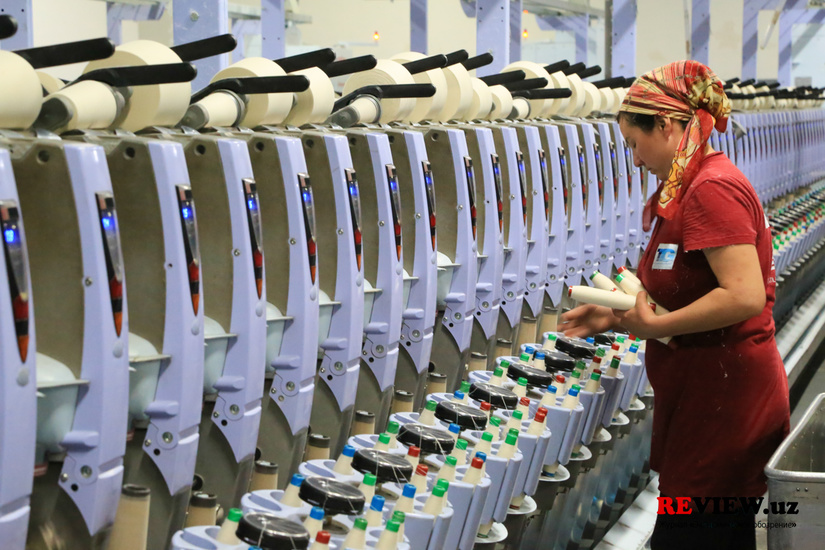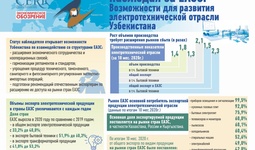Economic growth will be primarily ensured through the creation of competitive production chains and increased investment on this aim.
According to research carried by Harvard University, our country has all the opportunities and comparative advantages in the production of more than 50 industrial goods.
In particular, all conditions are available for making the petrochemical, metallurgical, engineering, electrical, pharmaceutical, construction, textile, leather and footwear, food industries, as well as areas related to the "green economy" become the "drivers" of the national economy.
From the Message of the President of the Republic of Uzbekistan to the Oliy Majlis, December 29, 2020.
The textile industry, despite the situation with the coronavirus pandemic, continues to demonstrate high growth rates, remaining one of the most dynamically developing sectors of the economy of Uzbekistan.
Over the past four years, the field has undergone dramatic changes. For example, the experimental creation of cotton-textile clusters for Uzbekistan as new forms of organizing the production chain from raw materials to finished products, reducing the export of cotton in order to fully process it in the republic, attracting advanced experience in the production of textile and clothing products, making steps to abolish the international boycott against textiles and clothing from Uzbekistan and expanding its presence in foreign markets. As a result, it enabled to create a solid reserve of stability of industries and to overcome the difficulties in country’s economy with minimal losses.
According to the State Statistics Committee, over 11 months of last year, textile production increased by 14.4 percent and by the end of 2020 maintained double-digit growth rates, which was not observed in the previous years. For comparison: in 2016, textile production increased by 9 percent only.
The pandemic was reflected in the garment industry in the form of a slowdown in growth, but it also remains positive at 2.9 percent. In previous years, the sewing production annually increased by almost 7 percent on average. Currently, the textile and clothing industries account for 12 percent of total industrial production. According to the statistics by Uztekstilprom Association, for the period of 2017-2020, the production of cotton yarn increased by 1.7 times, fabrics - by 2, knitted fabric - by 1.9, knitted products - by 1.8, hosiery - by 5.6 times.
Due to the increased emphasis on the development of textile and clothing production from the government, support in the form of tax preferences, concessional lending, subsidies, the industry has become more attractive for investment. So, according to the association, if in 2016 $190 million of investments were spent, then by the end of 2019 their volume increased 2.5 times and reached $ 473.9 million. The pandemic has slowed down investment activity in the textile and clothing industries, but the flow of investment has not stopped.
The rapid development of the industry was accompanied by the creation of jobs and an increase in employment. According to the Association "Uztekstilprom", the number of people employed in the textile and clothing industries for four years increased by almost 19 percent and reached 366.9 thousand people. The transition to cluster management of the production chain showed the effectiveness of this model, which led to an accelerated growth of cotton-textile clusters. If in 2017 only one cluster operated, in 2020 their number has already reached 95.
The priority areas of the industries under consideration for the development are further building up and unlocking export potential, increasing export volumes, diversifying foreign markets for domestic textiles and clothing. According to the State Statistics Committee, the export of textile and clothing and knitwear products in the first 11 months of 2020 increased by 15.4 percent (to $ 1.7 billion). Compared to 2016, the volume of exports in 2020 increased by 1.8 times. The policy of increasing the export of finished goods with high added value may also be profitable. For example, the export of ready-made knitwear and garments increased 2.1 times over the period under consideration. Currently, more than 563 types of textile products are exported to 69 countries of the world, while in 2018 - 348 types to 57 countries.
In the context of countries, there is a dynamic growth in exports both to traditional sales markets and to new ones. In particular, for 11 months of 2020, exports to Russia increased by 37 percent compared to 2016, and to neighboring countries - by 3.2 times. The volume of exports to non-CIS countries is also growing. For example, the export of textiles and clothing to China increased 2 times, Turkey - 3.3, Poland - 3.5, Italy - 3 times. Speaking about European countries, it should be noted that last year the European Commission made a decision to grant Uzbekistan the status of a beneficiary of the Generalized System of Preferences "GSP +" ahead of schedule. This will allow the supply of textile products duty-free to the EU countries', which is expected to lead to an increase in the supply of textiles and clothing from Uzbekistan to the European market. According to the Uztekstilprom Association, the GSP + regime will make it possible to increase the export of products by almost $ 300 million per year, and by 2025 - up to $ 1.2 billion.
Thus, the textile, garment and knitwear industries of Uzbekistan over the past four years have demonstrated sustainable dynamic development, maintaining the accumulated potential during the pandemic in 2020.





















leave a comment